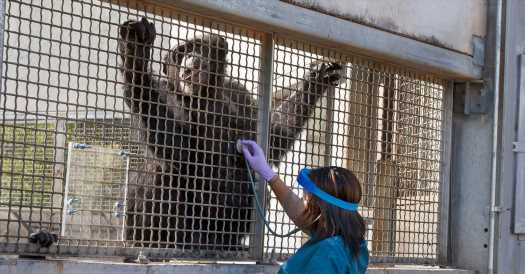In 2015, the National Institutes of Health decided to retire all the chimpanzees it owned. Since then, animal welfare groups have been pushing for quicker action, even as some of the facilities that once conducted experiments have urged caution, arguing that some chimps are too old and sick to be moved.
On Thursday the N.I.H. announced that an independent panel of veterinarians had determined that the 44 chimpanzees remaining at the Alamogordo Primate Facility, or A.P.F., in New Mexico were too ill to move, as the facility had contended.
In a statement, Dr. Francis S. Collins, the director of the N.I.H., said that the “N.I.H. expects that these 44 chimpanzees will live out the remainder of their lives at A.P.F. to ensure their safety and welfare.”
Rana Smith, the president of Chimp Haven, expressed disappointment at the decision. “We respect the medical opinions of the veterinary panel,” she wrote in an email. However, she said, “we firmly believe that sanctuary life is the best place for chimpanzees.”
Laura Bonar, chief program and policy officer for Animal Protection of New Mexico, said the panel seemed to have “rubber-stamped” the wishes of the Alamogordo facility. “The fact that they found all 44 of them should not go is unacceptable,” she said.
Dr. James M. Anderson, head of the division at N.I.H. that runs the chimpanzee program, said that all of the chimps were found by the veterinarians to be in the sickest category according to N.I.H. standards. That category includes “animals with life-threatening, systemic disease that poses a constant threat and could result in abrupt death.”
“I understand that people might be disappointed,” he added, and emphasized that the panel was independent. “We started this process, N.I.H. and this panel, with the assumption that all those animals should be moved,” he said.
The Alamogordo facility is no longer a laboratory, and the chimpanzees there are no longer subject to experiments. They live in social groups and have both indoor space and large, outdoor dome-like cages, with space to climb and swing.
It does not have the more open areas, some of them forested, of Chimp Haven, which grant many of the chimpanzees there a greater degree of freedom.
About 100 chimps have been moved from Alamogordo to Chimp Haven, which is in Louisiana, over the years. Others have died with the aging of the population. But some, although ill, are still relatively young for captives. Ms. Bonar mentioned Faylene, a chimp who will turn 37 in December and could live another 20 years or more.
Lori Gruen, a professor of philosophy at Wesleyan who is deeply involved in animal welfare issues and is a frequent visitor to Chimp Haven, was distressed by the decision. She wrote in an email that Chimp Haven had “successfully cared for chimpanzees with all of the health ailments that these 44 chimpanzees have.”
The panel's decision appears to be the end of the process, but Ms. Bonar encouraged the public to make their feelings known. “I think people should talk to their members of Congress,” she said. “These chimpanzees are supported by taxpayer dollars.”
N.I.H. owns 134 chimps at two other facilities in addition to the 44 at Alamogordo and 285 at Chimp Haven. How many of those other chimps are also ill is still under review.
Dr. Anderson said that the names of the veterinarians on the independent panel had not been posted because they need to be free of influence or pressure during the review. The names may be posted after the review, he said.
James Gorman is a science writer at large and the host and writer of the video series “ScienceTake.” He joined The Times in 1993 and is the author of several books, including “How to Build a Dinosaur,” written with the paleontologist Jack Horner.
Source: Read Full Article
